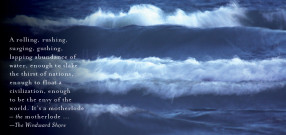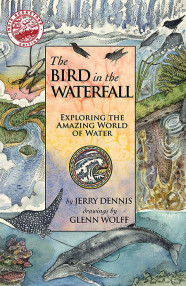LAKE MICHIGAN IS BLUE TODAY, the color of robins’ eggs and summer sky. Other days it shows blues as varied as a painter’s palette. I have never seen it match the electric indigo of the Gulf Stream or the surreal carnival blues of Caribbean flats, but I’ve seen it as powder blue, baby blue, and the blue of faded jeans. Some days it is as subtle as herons, others as vibrant as bluebirds. It can be periwinkle, phlox, or forget-me-not blue. It can be blueberry blue.
Water has some chameleon in it. It can mimic the bottom – khaki of sand, ash of zebra mussel beds – or reflects the sky or the trees along shore. It might be green with algae, red with suspended clay, or white with finely ground stone.
To appreciate these differences, we have to remember that water reveals two kinds of color. True color is usually a result of dissolved or suspended materials. If water is turbid it is probably because it contains suspended colloids so small that a single particle can take fifty years to settle.
But most of the water in the Great Lakes, although it appears in many shades of blue, is as transparent as the crystal stream emerging from a hose. The blue we see is its apparent color, loaned to it by reflections of the sky on the surface or by the separation of blue from sunlight’s spectrum in the depths of the lake.
My wife and I were talking about all this one evening as we walked the shore near our home. Gail, who is an artist, is intently aware of color. We made a game of listing the blues we saw in the lake. Gail saw phlox and iris, turquoise, sapphire, and lapis lazuli. I saw enameled cookware and razor blades and the hot blue at the base of a candle flame.
Then she challenged me to look more deeply and see the colors and shapes an artist sees. I concentrated and for the first time perceived water as a painter must, as a problem of technique. The waves as they came to shore no longer had mass and weight, but were two-dimensional arrangements of light and color. I saw not “waves” but wavering bars of blue, rose, and gold shifting on a flat background. John Ruskin concluded that “To paint water in all its perfection is as impossible as to paint the soul.” I understood why he thought so.
The wind fell, the water calmed, and the colors grew softer. My eyes swam – it turns out that looking is hard work. While Gail sat in the sand and sketched, I collected a pile of stones and threw skippers until the sun was gone.
(Adapted from The Bird in the Waterfall: Exploring the Amazing World of Water, illustrated by Glenn Wolff. Available now in an updated edition.)



Leave a Comment